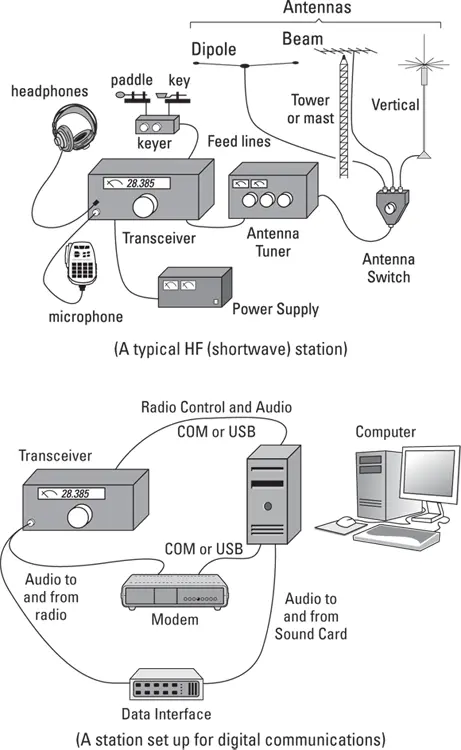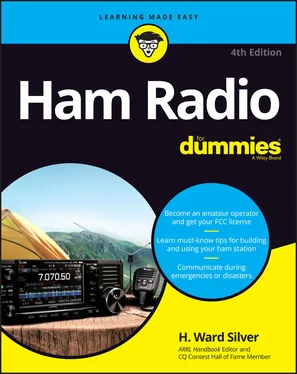1 ...6 7 8 10 11 12 ...25 For some hams, their entire station consists of a small handheld radio or two. Other hams operate on the go in a vehicle. Most hams also have a spot somewhere at home that they claim for a ham radio and associated gadgets. I discuss building and operating your own station in Part 4of this book. You can see examples of several stations, including mine, in Chapter 13. For now, though, here’s a list of the usual gear that makes up a ham’s station:
The radio: The modern radio transceiver, also referred to as a “rig,” combines a receiver and transmitter in a single compact package about the size of an average home entertainment receiver. Transceivers usually have a large tuning knob that controls the frequency, but computer-style displays and screens have replaced the dials and meters of older gear. Today’s software-based radios use a PC or tablet for controls and displays.
Computer: Most hams today have at least one computer in the station. Computers can control many of a radio’s functions. Using most digital signals simply wouldn’t be possible without them. Hams often use more than one computer at a time to perform different functions. Accessories and gadgets using Arduino and Raspberry Pi computers are quite common. Software allows you to control the operating frequency and many other radio functions from a keyboard. Computers can also keep your log, a record of your contacts. Computers can send and receive Morse code, too.
Handheld radio: Popular with new hams, a handheld transceiver is a convenient way to get started making contacts through local repeaters . Battery-powered, these radios can be used in a vehicle or any time you are away from your home station.
Mobile/base radio: These radios are used for regular mobile operation and in home stations. They produce much more output power than the small handheld models and are about the size of a mid-sized hardcover book.
Microphones, keys, and headphones: Depending on the station owner’s preferences, you’ll see a couple (or more) of these important gadgets, the radio’s original user interface. Microphones and keys range from imposing and chrome-plated to miniaturized and hidden. The old Bakelite headphones, or cans, are also a distant memory (which is good; they hurt my ears!), replaced by lightweight, comfortable, high-fidelity designs.
Antennas: In the station, you’ll find switches and controllers for antennas that live outside. A ham station tends to sprout antennas ranging from thin whips the size of pencils to wire antennas stretched through the trees and supersized directional beam antennas held high in the air on steel towers. See Chapter 12for more info on antennas.
Cables and feed lines: Look behind, around, or under the equipment and you find wires. Lots of them. The radio signals are piped through thick, round coaxial cables, or coax. Power is supplied by wires not terribly different in size from those that power a car stereo. I cover cables and feed lines in detail in Chapter 12.
Building a Basic Ham Radio Station
Although the occasional vintage vacuum-tube radio still glows in a ham’s station, today’s ham radios are sleek, microprocessor-controlled communications centers, as you see in this section.
 Ham stations are often referred to as a radio shack . That’s an old term from the very early days of radio when noisy and somewhat dangerous equipment was used. As a result, the station was often in a small shed of its own — literally a shack! Today, your “shack” is simply the place you keep your radio and other ham equipment. The days of bulbous vacuum tubes, jumping meters, and two-handed control knobs are largely in the past.
Ham stations are often referred to as a radio shack . That’s an old term from the very early days of radio when noisy and somewhat dangerous equipment was used. As a result, the station was often in a small shed of its own — literally a shack! Today, your “shack” is simply the place you keep your radio and other ham equipment. The days of bulbous vacuum tubes, jumping meters, and two-handed control knobs are largely in the past.
The stations shown here are very versatile — they can be used as a home or base station, a mobile station in a vehicle, or as a portable station. Equipment is available for very lightweight, low-power operation or heavy-duty full-power stations. Once you get a look at QST or CQ magazine or the many ham radio websites and social media, you’ll start to get a feel for the wide range of opportunities out there!
When you get your entry-class Technician license, you’ll probably set up a station like those in Figure 2-1. Many hams install a mobile rig in their vehicle, powering it from the battery. They often use a mag-mount antenna on the roof or trunk held on with a large magnet. You can also use these radios and antennas at home with an AC power supply and the antenna on a metal surface.
Many hams also have a small handheld radio. Figure 2-1 shows you some of the common accessories that are available. There are all sorts of batteries and battery chargers. For better range, you can use an adapter to connect a mag-mount antenna, replacing the flexible “rubber duck” antenna supplied with the radio.
Figure 2-2 shows the equipment in a station intended to operate on the “HF” or traditional “shortwave” bands. Radios are sold with a handheld microphone and an internal speaker, but you’ll have to provide your own headphones or external speaker. If you prefer Morse code (also referred to as CW for continuous wave ), you can use the traditional straight key (an old-fashioned Morse code sending device), but more commonly, you use a paddle and keyer, which are much faster to use than straight keys and require less effort. (Morse code operating is discussed in Chapter 8.)

FIGURE 2-1:A typical mobile FM station and a handheld transceiver with some common accessories.
The radio is connected with a feed line to one or more antennas. Three popular antenna types — dipole, beam, and vertical — are shown. A dipole is an antenna made from wire and typically connected to its feed line in the middle. Dipoles can be held up by poles or trees. A beam antenna sends and receives radio waves in a preferred direction; it’s often mounted on a mast or tower with a rotator that can point it in different directions. Antenna switches allow the operator to select one of several antennas. An antenna tuner sits between the antenna/feed line combination and the transmitter, like a vehicle’s transmission, to make the transmitter operate at peak efficiency. If the radio doesn’t use AC line power directly, a power supply provides the DC voltage and current.

FIGURE 2-2:A typical HF (shortwave) station and a station set up to use digital communications.
A computer can be used to exchange data over the air using a digital mode. Figure 2-2 shows typical digital mode setups. Some radios have USB ports that include support for digital audio along with control of the radio. A data interface passes audio signals between the radio’s speech circuits and computer. For some types of data, a computer can’t do the necessary processing, so a modem is used. The computer talks to the modem through a COM or USB port.
Many radios are designed to be easy to use over an Internet connection as a remote station . Operating this way is called remote control . This is a perfect solution if you can’t set up a station at home. Some hams share a remote station they can all operate. There are even remote station services that provide access to excellent stations! You can get a taste of remote operating by trying some of the online receivers at www.websdr.org .
Читать дальше

 Ham stations are often referred to as a radio shack . That’s an old term from the very early days of radio when noisy and somewhat dangerous equipment was used. As a result, the station was often in a small shed of its own — literally a shack! Today, your “shack” is simply the place you keep your radio and other ham equipment. The days of bulbous vacuum tubes, jumping meters, and two-handed control knobs are largely in the past.
Ham stations are often referred to as a radio shack . That’s an old term from the very early days of radio when noisy and somewhat dangerous equipment was used. As a result, the station was often in a small shed of its own — literally a shack! Today, your “shack” is simply the place you keep your radio and other ham equipment. The days of bulbous vacuum tubes, jumping meters, and two-handed control knobs are largely in the past.












